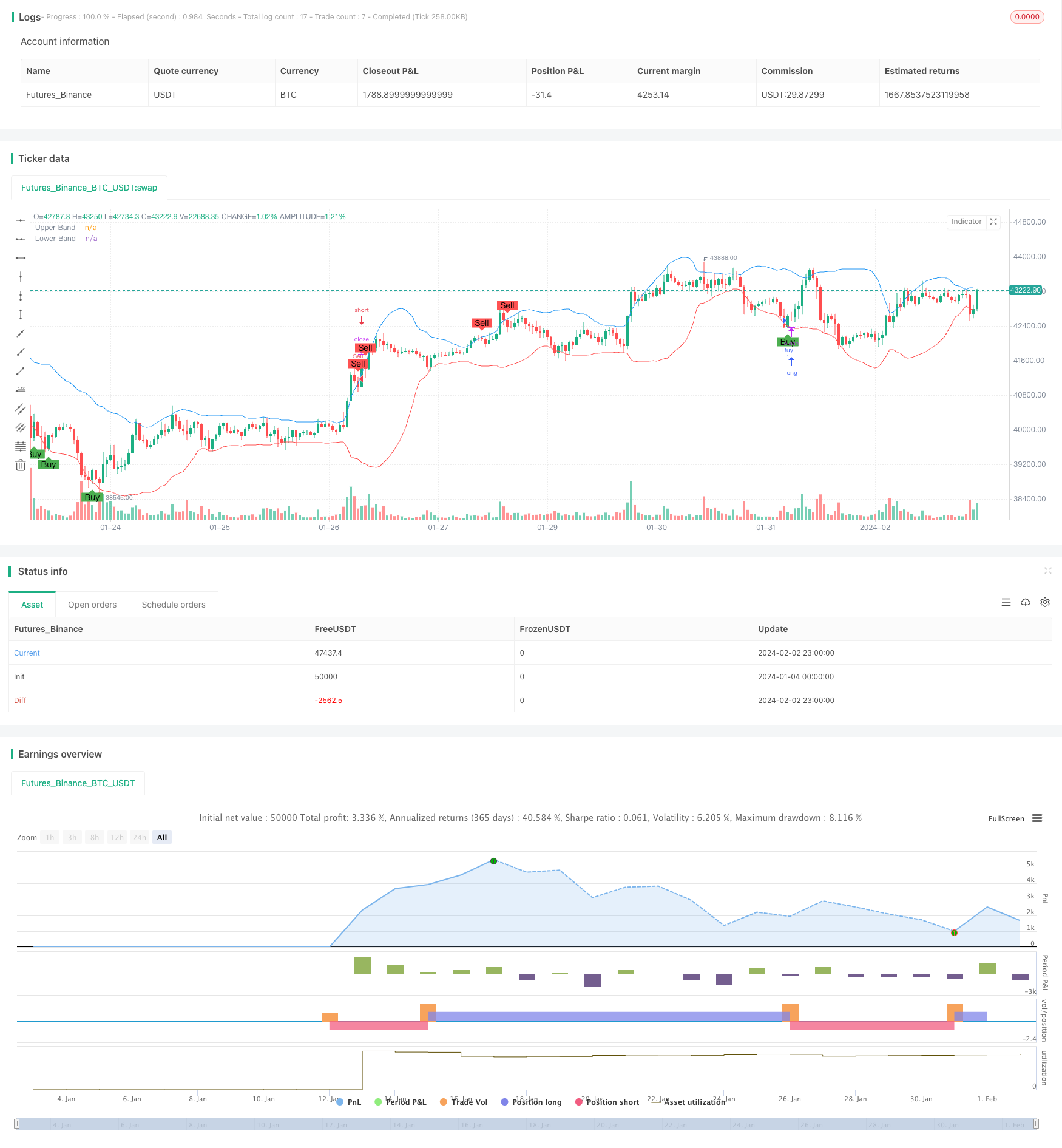Quantitative Trading Strategy Based on RSI and Bollinger Bands
Author: ChaoZhang, Date: 2024-02-04 15:22:41Tags:

Overview
This article analyzes in depth a quantitative trading strategy based on the RSI and Bollinger Band technical indicators. By fully utilizing the advantages of RSI in identifying overbought and oversold conditions and Bollinger Bands in judging price volatility, this strategy enables more accurate identification of inflection points in market trends.
Strategy Principle
- RSI Principle
RSI stands for Relative Strength Index. It is a technical indicator that measures the magnitude of recent price changes to evaluate overbought or oversold conditions. RSI ranges from 0 to 100. Values over 70 indicate an overbought state and values below 30 indicate an oversold state. The emergence of overbought and oversold conditions often implies a potential price reversal.
- Bollinger Bands Principle
Bollinger Bands consist of a middle band, an upper band and a lower band. The middle band is a n-day moving average, while the upper band is set two standard deviations above the middle band and the lower band is set two standard deviations below. Touching or crossing these bands indicates increased volatility and an upcoming reversal.
- Strategy Construction
This strategy combines RSI to determine overbought and oversold entry signals and Bollinger Bands to ascertain price volatility, generating trading signals when RSI enters overbought/oversold territory concurrently with prices touching the Bollinger bands. This allows it to capture trend turning points and achieve buying low and selling high.
Advantage Analysis
Fully utilizes RSI’s strength in identifying overbought and oversold conditions by setting reasonable thresholds to avoid false signals.
Leverages Bollinger Bands to judge price fluctuation and volatility then formulates trading decisions together with RSI, enhancing decision accuracy.
RSI verifies signals generated by Bollinger Bands and vice versa to reduce trading mistakes.
Capably detects price uptrend and downtrend reversals to seize price reversal opportunities.
Risk Analysis
False signals generated by technical indicators cannot be fully avoided.
Improper RSI parameter or Bollinger Band parameter settings may lead to missing trading chances or unnecessary trades.
Potential stop loss risks still exist under sharp market fluctuations.
Parameters need reasonable adjustments to suit different products and market environments.
Optimization Directions
Test and optimize RSI and Bollinger Band parameters to find optimum parameter sets.
Add stop loss strategies to strictly control losses per trade.
Incorporate other indicators like KDJ and MACD to enhance robustness.
Build auto parameter tuning module to dynamically adapt strategy parameters to current market conditions.
Conclusion
The quantitative trading strategy based on RSI and Bollinger Bands, through double indicator verification and combination, can effectively determine price trend inflection points. This strategy is simple, practical, and easy to implement, with the advantages of high accuracy, frequent trading, and easy optimization. However risk control remains vital alongside parameter testing, stop loss tactics, and indicator optimization to improve strategy stability and profitability.
/*backtest
start: 2024-01-04 00:00:00
end: 2024-02-03 00:00:00
period: 1h
basePeriod: 15m
exchanges: [{"eid":"Futures_Binance","currency":"BTC_USDT"}]
*/
//@version=5
strategy("RSI & Bollinger Bands Strategy", overlay=true)
// RSI ayarları
rsi_length = input.int(14, title="RSI Length")
overbought = input.int(70, title="Overbought Level")
oversold = input.int(30, title="Oversold Level")
rsi = ta.rsi(close, rsi_length)
// Bollinger Bands ayarları
length = input.int(20, title="BB Length")
mult = input.float(2.0, title="BB Deviation")
basis = ta.sma(close, length)
dev = mult * ta.stdev(close, length)
upper = basis + dev
lower = basis - dev
// Alım-satım sinyalleri
longCondition = ta.crossover(rsi, oversold) and ta.crossover(close, lower)
shortCondition = ta.crossunder(rsi, overbought) and ta.crossunder(close, upper)
// Alım ve satım koşullarına göre işlem yapma
if (longCondition)
strategy.entry("Buy", strategy.long)
if (shortCondition)
strategy.entry("Sell", strategy.short)
// Alım ve satım sinyallerini görselleştirme
plotshape(series=longCondition, title="Buy Signal", location=location.belowbar, color=color.green, style=shape.labelup, text="Buy")
plotshape(series=shortCondition, title="Sell Signal", location=location.abovebar, color=color.red, style=shape.labeldown, text="Sell")
// Bollinger Bantları'nı grafik üzerine çizme
plot(upper, title="Upper Band", color=color.blue)
plot(lower, title="Lower Band", color=color.red)
- Moving Average Crossover Strategy
- Dual Moving Average Trend Tracking Strategy
- Quadratic Momentum Double Indicators Timing Strategy
- Renko and Relative Vigor Index Trend Following Strategy
- Swing Trend Moving Average Strategy
- Bollinger Band, Moving Average and MACD Combined Trading Strategy
- Momentum Price Climbing Crypto Currency Strategy
- Momentum Trading Strategy Based on Multi-factor Model
- Adaptive Bollinger Bands Trend Tracking Strategy
- Improved RSI Breakout Strategy with Stop Loss and Take Profit
- Quantitative Trading Strategy Based on SMA and Rolling Trendline
- Stochastic Weekly Options Trading Strategy
- Powerful EMA and RSI Quantitative Trading Strategy
- Bollinger Bands and RSI Combination Trading Strategy
- Demigod Candlestick MACD Divergence Trend Following Strategy
- Dual Moving Average Cross Timeframe Trading Strategy
- Dual Indicator Stochastic RSI and EMA Trading Strategy
- SMA Crossover Bullish Trend Following Strategy
- Bollinger Bands Breakout Quantitative Trading Strategy
- Trend Following Strategy Based on Multi-Period SMA